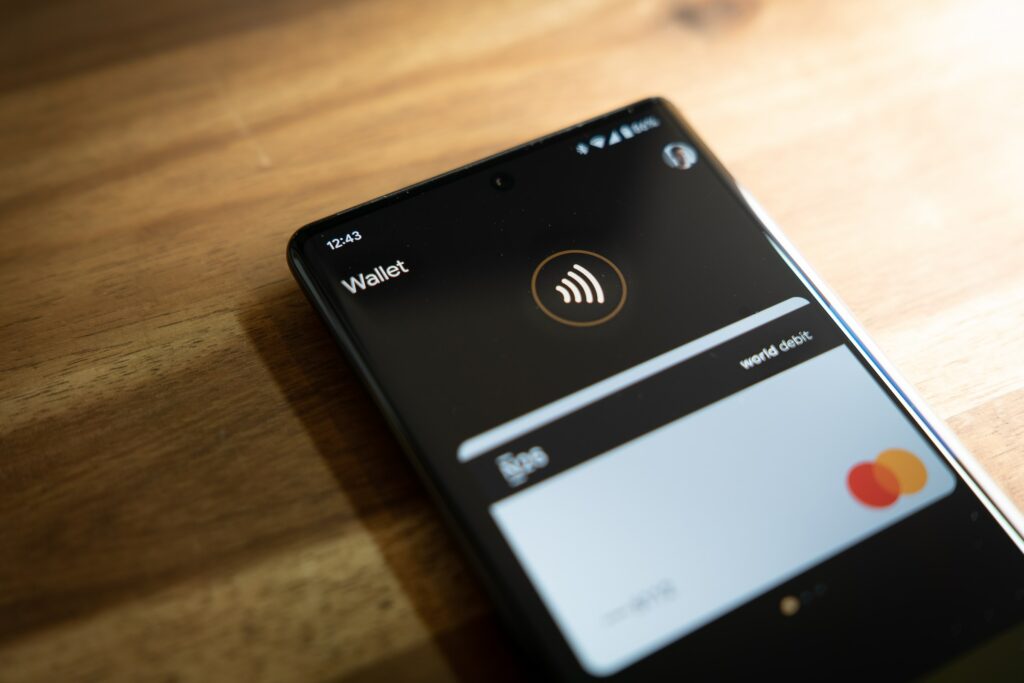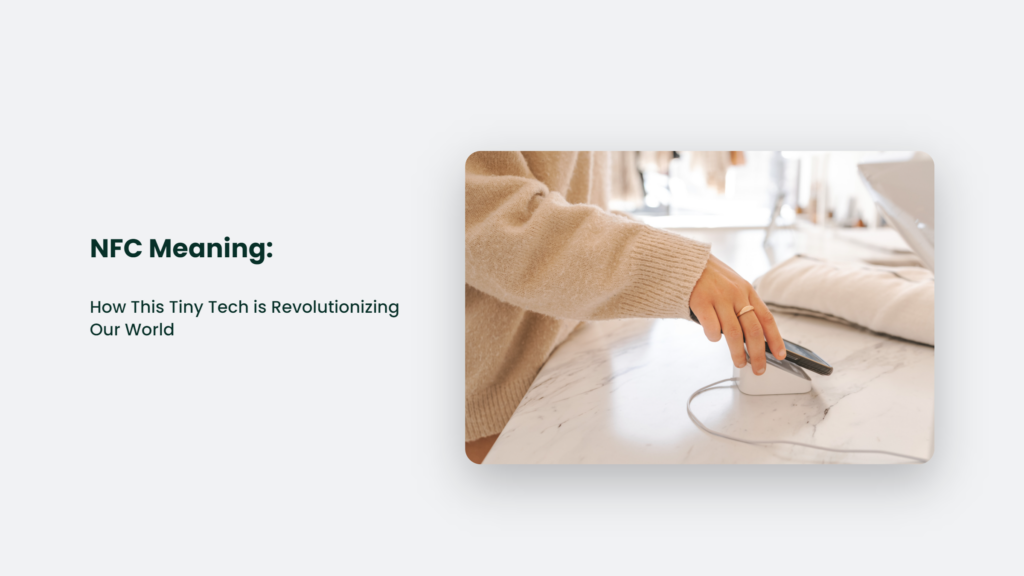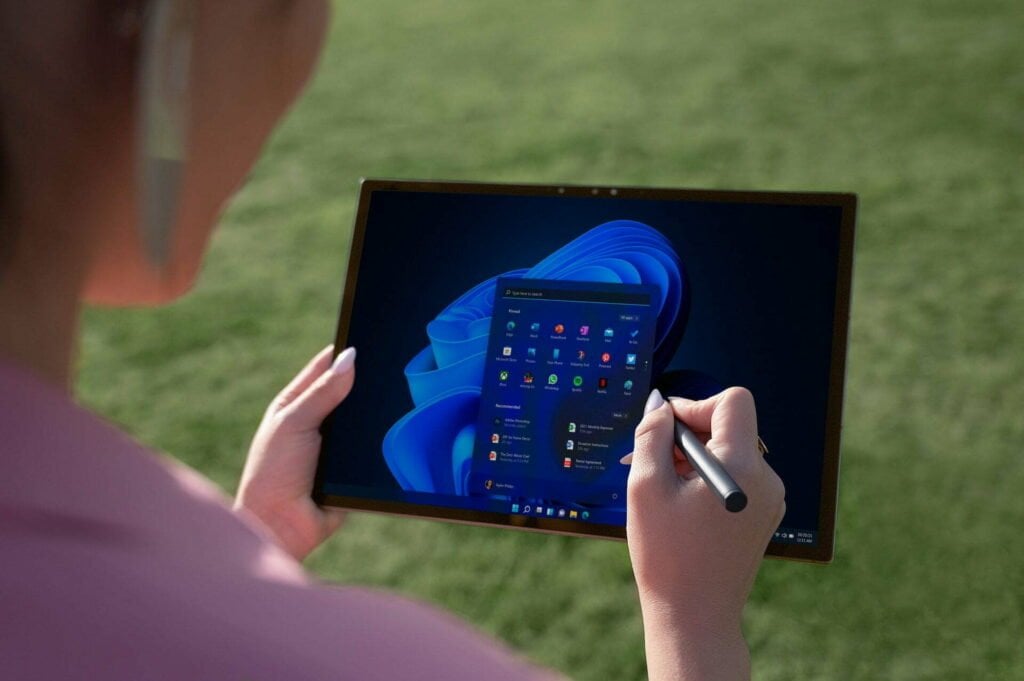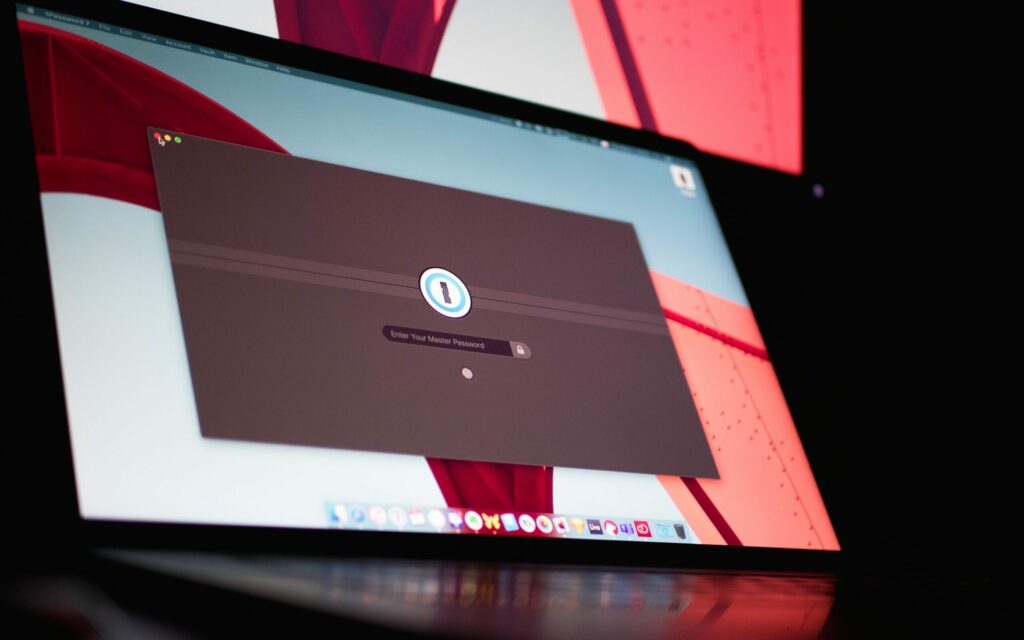

NFC Meaning: How This Tiny Tech is Revolutionizing Our World

As Seen On
Picture this: you’re at a bar with your friends, and you’re arguing about whether Kanye West’s “My Beautiful Dark Twisted Fantasy” is a work of absolute genius or a cacophony of narcissistic noise. Suddenly, someone suggests you all put it to a vote by tapping your phones together, and just like that, a lively debate becomes a democratic decision. What sorcery is this? It’s not magic, folks; it’s NFC.
But what is the meaning of NFC? And how is this tiny tech transforming our lives? Grab your favourite beverage, buckle up, and let’s dive into the weird and wonderful world of Near Field Communication.

What Does NFC Stand For: NFC Meaning
First things first: NFC stands for Near Field Communication. It’s a short-range wireless technology that allows devices to communicate without needing an internet connection. Think of it as Bluetooth’s introverted cousin: it doesn’t like to roam far, but it’s all about connection when it’s near.
How Does NFC Work?
NFC uses magnetic field induction, which is a fancy way of saying it allows two devices to share data when they’re close. When two NFC-enabled devices are brought close together (usually within 4 centimetres), they establish a connection and can transfer information between them.
For example, you want to beam your best friend to the latest hilarious cat video. With NFC, you can bring your phones close together, and presto! Your friend is now doubled over in laughter, marvelling at the sheer genius of feline antics.
5 Ways NFC is Changing the Game
NFC might sound like the stuff of science fiction, but it’s quickly becoming an essential part of our daily lives. Here are five ways this tiny tech is revolutionizing the world around us:
Payments: A Seamless Financial Future
NFC technology has revolutionized how we make payments, rendering cash and card swipes relics of the past. The contactless payment experience has become more secure, efficient, and convenient thanks to NFC-enabled phones and credit cards.
The widespread adoption of this technology is evident in the statistics: a 2021 study by Juniper Research revealed that over 50% of global point-of-sale transactions were contactless by 2021, which has only grown since then.
With NFC payments, transaction times are significantly reduced, streamlining the checkout process and cutting down on queues. Additionally, this technology offers enhanced security features such as tokenization and encryption, providing an extra layer of protection against fraud and data breaches.
Smart Homes: A Tap Away From Total Control
NFC has transformed how we interact with our homes, turning once-futuristic concepts into a present-day reality. Home automation systems like Apple HomeKit and Google Home have integrated NFC technology, allowing users to manage their smart homes with a simple tap on their phones.
This seamless connectivity extends to controlling thermostats, lighting, security systems, and more.
This user-friendly approach to home automation encourages energy efficiency and sustainability by enabling remote monitoring and control of energy consumption. Furthermore, the convenience offered by NFC technology promotes accessibility, making smart homes more inclusive for individuals with disabilities or limited mobility.
Public Transportation: The Fast Track to Smooth Commutes
Navigating public transportation has never been easier, thanks to the transformative power of NFC. By replacing traditional methods like cash and card swipes, commuters can now access transportation services with just a tap of their NFC-enabled phone or transit card.
Major cities like London, New York, and Tokyo have already embraced NFC technology, with many more following suit.
The adoption of NFC in public transportation systems reduces wait times, streamlines ticketing processes, and offers real-time updates on schedules and delays. This technology also enables the implementation of flexible fare structures and personalized travel plans, improving the overall commuting experience.
Marketing: Tapping into the Future of Advertising
Gone are the days when QR codes were the cutting edge of marketing. NFC has ushered in a new era of interactive advertising with NFC-enabled posters, billboards, and business cards.
By tapping their phones on these promotional materials, potential customers can instantly access information about products, services, and special offers.
This innovative marketing approach offers numerous benefits, including increased engagement, enhanced data collection, and improved targeting capabilities. Brands can now provide personalized content, measure campaign effectiveness, and gain valuable insights into consumer behaviour, all thanks to NFC technology.
Healthcare: NFC to the Rescue
The healthcare industry is also experiencing a paradigm shift, with NFC technology streamlining processes and improving patient care. Doctors and nurses can now quickly access patient information, track medications, and monitor vital signs, all with the help of NFC-enabled devices.
This technology has far-reaching implications, from enhancing patient safety and reducing the risk of errors to improving efficiency in healthcare settings. The potential of NFC in healthcare is vast, with the global market expected to reach $3.18 billion by 2025.
NFC vs. Bluetooth: The Ultimate Showdown
Two major players have emerged as wireless communication technologies advance: NFC (Near Field Communication) and Bluetooth. While both offer unique benefits, understanding their distinct differences is essential to determine which one is best suited for specific tasks. So let’s dive into a more in-depth analysis of NFC and Bluetooth in this ultimate showdown.
Range: Distance Makes All the Difference
One of the most significant differences between NFC and Bluetooth is their range of capabilities. Bluetooth 5.0 has an impressive range of up to 10 meters (33 feet), making it perfect for situations that require a more extended reach. It is particularly useful for streaming music to wireless speakers, connecting your phone to your car’s audio system, or transferring files between devices in the same room.
On the other hand, NFC has a limited range of just 4 centimetres (1.6 inches), meaning devices must be close to establishing a connection. While this may seem like a disadvantage, NFC’s short range is actually a strength in certain scenarios, such as secure data transfers and quick interactions.
Speed: The Need for (Instant) Speed
When it comes to connection speed, NFC outshines Bluetooth. Establishing a Bluetooth connection requires pairing, which can take a few seconds. NFC, however, offers an almost instantaneous connection, making it perfect for time-sensitive interactions like contactless payments, sharing photos, or exchanging contact information.
The faster connection speed of NFC is especially beneficial in situations where users need to make numerous connections in a short period, such as during a networking event or while using public transportation.
Power Consumption: Going Green with NFC
In terms of energy efficiency, NFC has the upper hand over Bluetooth. While both technologies use power to transmit data, NFC only consumes energy when actively transmitting the information. It makes it a more environmentally friendly option for short-range communication.
On the other hand, Bluetooth has a higher power consumption due to its longer-range capabilities and the need to maintain a continuous connection between devices. It can lead to faster battery drain in devices that rely on Bluetooth for extended periods.
Security: Keeping Your Data Safe and Sound
Both NFC and Bluetooth offer security features to protect user data. However, NFC’s limited range provides an added layer of security, as it requires devices to be in close physical proximity to establish a connection. It makes it more difficult for potential hackers or eavesdroppers to intercept data transmissions.
With its extended range, Bluetooth is more susceptible to security breaches. Although recent versions of Bluetooth have implemented enhanced security measures, such as Secure Simple Pairing (SSP) and the Low Energy Secure Connections (LESC) feature, the technology still requires users to remain vigilant and take necessary precautions to protect their data.
Conclusion: Complementary Technologies, Not Competitors
While it may seem like NFC and Bluetooth are locked in an epic battle for wireless communication supremacy, the reality is that they are more like partners in crime, each with their unique strengths.
NFC excels in situations that require quick interactions, secure data transfers, and energy efficiency, while Bluetooth shines in scenarios that demand more extended-range capabilities and continuous connections between devices.
Ultimately, both NFC and Bluetooth have their place in our increasingly connected world. Users can make informed decisions about which technology best suits their specific needs by understanding their distinct advantages and limitations. So, rather than viewing these technologies as adversaries, we should embrace them as complementary solutions that work together to enhance our daily lives.
Frequently Asked Questions:
Are all smartphones NFC-enabled?
Most modern smartphones are equipped with NFC capabilities, but it’s always a good idea to double-check your specific device’s specifications.
Can I use NFC with my smartwatch?
Absolutely! Many smartwatches now come with NFC capabilities, allowing you to do things like make contactless payments or access secure areas with just a tap of your wrist.
Is NFC safe for credit card transactions?
Yes, NFC is considered safe for credit card transactions due to its short range and built-in security features. However, staying vigilant and protecting your personal information is always important.
Can I use NFC to share large files?
While NFC is great for sharing small files like photos or contact information, it’s not ideal for large files due to its limited data transfer speeds. In this case, Bluetooth or Wi-Fi would be a better option.
How do I know if a device is NFC-enabled?
Many NFC-enabled devices will have the NFC logo displayed on them, but it’s always a good idea to check the device’s documentation for confirmation.
The Bottom Line:
In conclusion, NFC may not have the range of its cousin Bluetooth, but it’s quickly making a name for itself as a versatile and powerful force in wireless communication. From contactless payments to smart homes, public transportation to marketing, and even healthcare, NFC is revolutionizing the way we interact with the world around us.
So the next time you’re at a bar with friends debating the merits of your favourite album, remember: NFC is here to help make your life just a little bit easier. And who knows, maybe one day we’ll even be able to vote with a simple tap of our phones. Until then, keep tapping away and embracing the power of this tiny tech titan.
Konger
Up until working with Casey, we had only had poor to mediocre experiences outsourcing work to agencies. Casey & the team at CJ&CO are the exception to the rule.
Communication was beyond great, his understanding of our vision was phenomenal, and instead of needing babysitting like the other agencies we worked with, he was not only completely dependable but also gave us sound suggestions on how to get better results, at the risk of us not needing him for the initial job we requested (absolute gem).
This has truly been the first time we worked with someone outside of our business that quickly grasped our vision, and that I could completely forget about and would still deliver above expectations.
I honestly can't wait to work in many more projects together!
Disclaimer
*The information this blog provides is for general informational purposes only and is not intended as financial or professional advice. The information may not reflect current developments and may be changed or updated without notice. Any opinions expressed on this blog are the author’s own and do not necessarily reflect the views of the author’s employer or any other organization. You should not act or rely on any information contained in this blog without first seeking the advice of a professional. No representation or warranty, express or implied, is made as to the accuracy or completeness of the information contained in this blog. The author and affiliated parties assume no liability for any errors or omissions.

